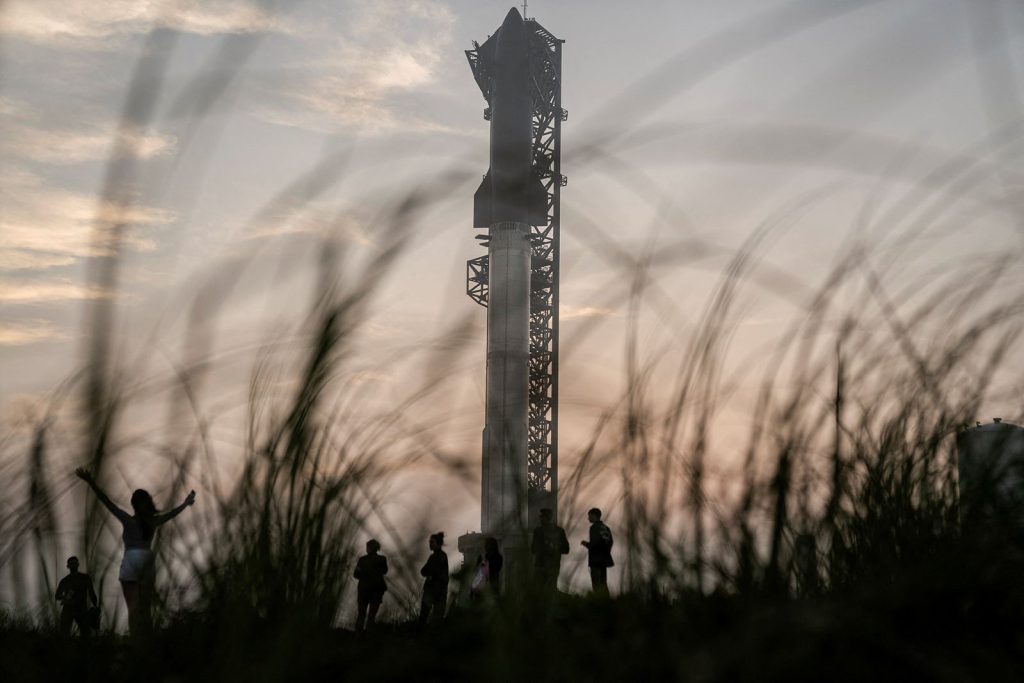By Jackie Wattles, CNN
(CNN) — After two nail-biting and explosive test flights in 2023, a SpaceX Starship rocket is back on the launchpad at the Starbase facility in Boca Chica, Texas.
The deep-space rocket system is aiming to make it through an hour-long integrated flight test. If successful, the spacecraft will splash down in the Indian Ocean, putting the gargantuan vehicle in a position to move on to more complex test flights and, eventually, carry NASA astronauts to the moon’s surface.
The target launch time was pushed back several times Thursday morning, most recently to give officials more time to clear some wayward boats out of nearby keep-out zones for safety reasons.
The current launch target is 8:10 a.m. CT (9:10 a.m. ET). SpaceX also said earlier on Thursday that it expects there is about a 70% chance that weather conditions will be good enough for takeoff.
The launch could take place anytime during a 110-minute window that opened at 7 a.m. CT (8 a.m. ET) Thursday, according to an email from SpaceX sent Wednesday afternoon. The event will begin streaming live on the company’s website about 30 minutes before the highly anticipated takeoff.
SpaceX considers the Starship system crucial to its founding mission: to carry humans to Mars for the first time. And critically, NASA has chosen Starship as the landing vehicle that will ferry its astronauts to the lunar surface on the Artemis III mission slated to take off as soon as September 2026.
If all goes according to plan during Thursday’s test flight, the Super Heavy booster — the first stage, or bottommost part, of the launch vehicle — will roar to life and soar out over the Gulf of Mexico.
Nearly three minutes into flight, the Super Heavy booster will burn through most of its fuel and break away from the Starship spacecraft, the upper stage that rides atop the Super Heavy.
The booster will then aim to make an autonomous, controlled landing in the ocean, while the Starship spacecraft uses its own engines to continue propelling itself to breakneck speeds.
Aiming for orbital speeds
SpaceX CEO Elon Musk has said a primary goal of these early test flights is to get Starship to orbital speeds — velocities quick enough to allow the spacecraft to enter a stable orbit around Earth.
Typically, such a feat requires speeds topping 17,500 miles per hour (28,000 kilometers per hour).
Starship will not, however, aim to actually enter orbit on this flight. Instead, the spacecraft will make a hard landing in the Indian Ocean — hopefully more than 230 miles (370 kilometers) away from the nearest land mass, according to documents published by the Federal Aviation Administration, which licenses commercial rocket launches.
Starship tests and tech demos
Starship will have to burn its engine for about six minutes before it enters a coasting phase. The spacecraft will then run through a few key tests and tech demonstrations.
First, Starship will attempt to open its payload door — a hatch that must swing ajar for the capsule to deploy satellites into space on future missions.
Then, SpaceX will also carry out what the company is calling a “propellant transfer demonstration.” The goal is to move some of the propellant on board the Starship vehicle from one tank to another, according to a December email from NASA explaining the test.
SpaceX engineers designed that demo to begin hashing out how Starship will be refueled on future missions while it’s in orbit.
NASA Artemis moon mission
Topping off the spacecraft’s fuel will be critical for Starship’s high-profile missions down the road.
When Starship makes a journey to the moon under NASA’s Artemis program — it will have to sit in orbit close to Earth as SpaceX launches separate vehicles that will transport only fuel to the spacecraft. To get to the moon, SpaceX may have to make more than a dozen refueling trips.
SpaceX received approval from regulators on Wednesday to carry out this latest test flight.
About 49 minutes into flight, the Starship vehicle will attempt to plunge back toward the ocean.
SpaceX’s explosive test-flight process
Musk has said he’s more confident this flight will be successful compared with the 2023 attempts. A success would potentially give the company crucial data that could allow Starship to move on to more difficult test flights.
“I don’t want to jinx it, but I think the probability of reaching orbit is good — 80%,” he said during a recent talk posted to social media . “Certainly the third flight is a much better rocket than flights one or two.”
Still, SpaceX officials have repeatedly said the company does not expect 100% accuracy on these early test flights.
“Each of these flight tests continue to be just that: a test. They aren’t occurring in a lab or on a test stand, but are putting flight hardware in a flight environment to maximize learning,” the company said in a statement posted to its website. “This rapid iterative development approach has been the basis for all of SpaceX’s major innovative advancements.”
The-CNN-Wire
™ & © 2024 Cable News Network, Inc., a Warner Bros. Discovery Company. All rights reserved.






More Stories
More women needed in ICT field
Campbell’s suspension reduced
BNOC workers back on the job